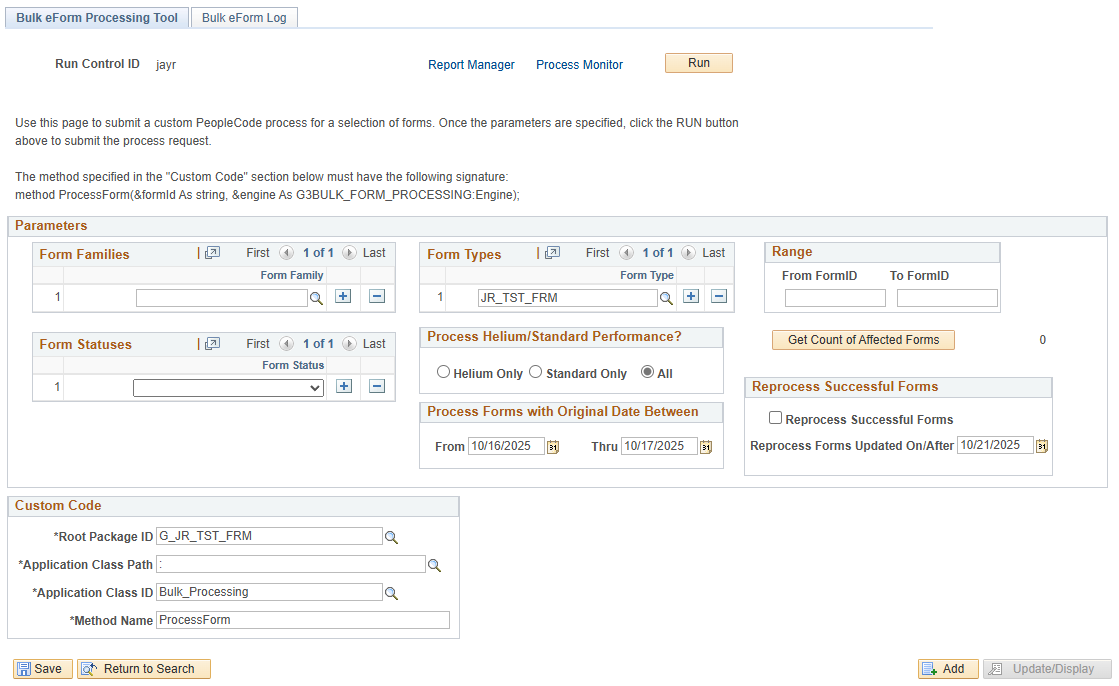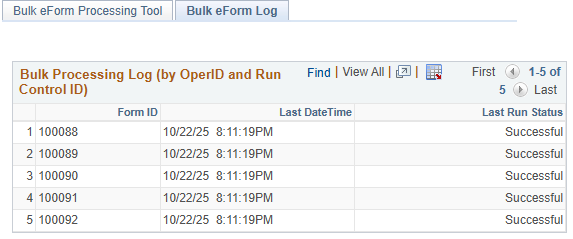Bulk eForm Processing Tool
The Bulk eForm Processing Tool is a utility that enables processing a large volume of forms at once. Similar in nature to the Form Key Update Utility, this new tool offers greater flexibility in the tasks you can perform with it, such as easily updating existing forms' values.
Navigation: Manage GT eForms 3.x > GT Utilities > Bulk eForm Processing Tool
Introduced with GT eForms 3.75.00
Providing a Run Control
A Run Control ID is an identifier for the process you are going to run with your configuration. It helps in tracking and managing the execution of the process. Each Run Control ID is unique and ensures that the process runs with the specified parameters.
Select an existing Run Control ID, or click 'Add a New Value' to provide a new Run Control ID.
 If 'Add a New Value' is clicked, type in a new Run Control ID
If 'Add a New Value' is clicked, type in a new Run Control ID
Bulk eForm Processing Tool
The Bulk eForm Processing Tool tab allows you to set parameters to the filter forms that need to be processed, the location of the code that is used in the process as well as the ability to run the process.

Run Controls

| Field | Value/Use |
|---|---|
| Run Control ID (Read Only) | Displays the Run Control ID for the current process and is read-only |
| Report Manager (link) | Opens the Report Manager page in a modal window. This is the standard PeopleSoft window. |
| Process Monitor (link) | Opens the Process Scheduler page in a modal window. This is the standard PeopleSoft window. |
| Run (button) | Opens the Process Scheduler Request panel. This is the standard PeopleSoft window. |
Parameters
Parameters are fields used to filter forms that will be passed to your custom processing logic.

| Field | Value/Use |
|---|---|
| Form Families | Choose Form Families. Use the plus button to add additional families. Use the minus button button to remove families. |
| Form Statuses | Choose Form Statuses. Use the plus button to add additional statuses. Use the minus button button to remove statuses. |
| Form Types | Choose Form Types. Use the plus button to add additional form types. Use the minus button button to remove form types. |
| Process Helium/Standard Performance? | Choose All unless you need to differentiate between Helium Only or Standard Only forms. |
| Process Forms with Original Date Between | Enter a From date and a Thru date to choose forms based on the Original Date. |
| Range | Enter a From FormID and a Thru FormID to choose forms by FormID. |
| Get Count of Affected Forms (Button) | Click the button to get a count of the forms to be processed. |
| Reprocess Successful Forms | Check the box to reprocess forms that have already be processed. By default if the form has already been successfully processed by the matching Run Control ID, it will not be processed again when kicking the process off again. Checking the ‘Reprocess Successful Forms’ checkbox removes that restriction allowing all form IDs that meet the other criteria to be processed, even if they were processed successfully in a previous run with the current control ID. |
| Reprocess Forms Updated On/After | The ‘Reprocess Forms Updated After’ allows a date be specified. Form IDs successfully processed on or after the selectd date will be reporcessed. NOTE: Checking the ‘Reprocess Successful Forms’ checkbox will bypass the date and reprosses all forms. |
Processing Logic - Custom PeopleCode
The Processing Logic must be implemented as a PeopleCode Application Class method. You can either create a new Application Package and Class or use existing ones. When the tool runs, it calls this method once for each Form ID identified by the values selected on the configuration page.
Creating the PeopleCode method requires a technical resource, but that person can focus solely on the custom business logic needed for each form. The tool handles all other tasks — identifying the relevant forms and executing the process through the Process Scheduler.
The custom processing method must use the following signature:
method ProcessForm(&formId As string, &engine As G3BULK_FORM_PROCESSING:Engine);
| Field | Value/Use |
|---|---|
| Root Package ID | The name of the Application Package that contains the Application Class with the method to execute. |
| Application Class Path | The name of the Sub Package that contains the Application Class with the method to execute. If there is no Sub Package, enter a colon (:). |
| Application Class ID | The name of the Application Class that contains the method to execute. |
| Method Name | The name of the method to execute (for example, ProcessFormin the example above).The method can have any name, but it must accept two parameters: 1. a string - this will be set to the current Form ID when the method is called. 2. a G3BULK_FORM_PROCESSING:Engine object. |
Example Processing Code
This is a simplified example that will open the form and always update the Dept ID field to the value '20000'. The SerializeBuffer method must be called to store the change.
import G3BULK_FORM_PROCESSING:Engine;
import G3FORM:Form;
class Bulk_Processing
method ProcessForm(&formId As string, &engine As G3BULK_FORM_PROCESSING:Engine);
end-class;
method ProcessForm
/+ &formId as String, +/
/+ &engine as G3BULK_FORM_PROCESSING:Engine +/
MessageBox(0, "", 0, 0, "Processing Form ID: " | &formId);
Local G3FORM:Form &G3Form = &engine.StandUpHeliumForm_AweAndDataOnly(&formId);
&G3Form.record("PAGEREC").field("DEPTID").Value = 20000;
&G3Form.SerializeBuffer();
end-method;
Bulk eForm Log
The Bulk eForm Log is a list of the forms processed for the OperID and Run Control ID.

| Field | Value/Use |
|---|---|
| Form ID | Form IDs processed by the bulk tool for the OperID and Run Control ID |
| Last Date Time | Last Date / Time the form was processed by the bulk tool |
| Last Run Status | Last status the form was processed by the bulk tool. The status may be Successful or Failed. |